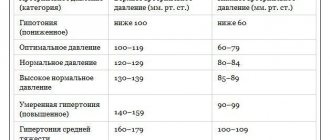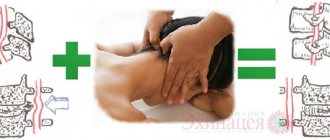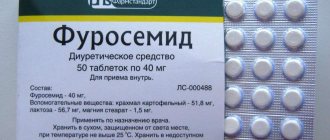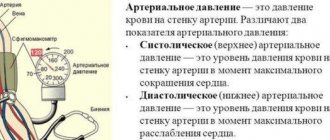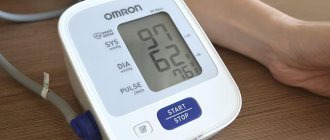Valoserdin is a complete analogue of the well-known drug Valocordin. This or that remedy is necessarily present in the home medicine cabinet in almost every family, since it has calming and antispasmodic properties, helps to sleep and relieve nervous tension.
But the question is, does Valoserdin increase or decrease blood pressure, can it be used for arterial hypertension and hypotension? How to use the drug correctly so as not to further aggravate existing health problems? Today we need to understand this topic in more detail and find out the effect of Valoserdin on blood pressure (BP).
Nosological classification (ICD-10)
- F48.9 Neurotic disorder, unspecified
- G47.0 Disturbances in falling asleep and maintaining sleep [insomnia]
- G90 Disorders of the autonomic nervous system
- I99 Other and unspecified circulatory system disorders
- K58.9 Irritable bowel syndrome without diarrhea
- R00.0 Tachycardia, unspecified
- R10.4 Other and unspecified abdominal pain
- R45.1 Restlessness and agitation
- R45.4 Irritability and anger
Pharmacodynamics
A combined drug, the therapeutic effect of which is determined by the pharmacological properties of the components included in its composition. Has a sedative and antispasmodic effect.
Phenobarbital has sedative and mild hypnotic effects. Helps reduce central nervous system excitation and facilitate the onset of natural sleep, enhancing the sedative effect of other components.
Ethyl bromizovalerianate also has a sedative (similar to the effect of valerian) and antispasmodic effects.
How does the product affect blood pressure?
The use of Valoserdin for high blood pressure is approved by cardiologists. Since the product has a mild sedative, calming and antispasmodic effect, during its use the blood vessels dilate, and the problem of increased nervous tension is solved. Isovaleric acid, present in the composition of the medication, has an irritating effect on the receptors of the mucous membrane, normalizes narrowed capillaries and stabilizes the blood pressure in them.
The action of Valoserdin becomes more effective for patients with signs of insomnia, outbursts of aggression, and the manifestation of causeless anxiety
The effect of the drug appears within a few minutes after oral administration - the person relaxes due to the elimination of spasms and calmly falls asleep. How Valoserdin lowers blood pressure can be understood by explaining this action using the laws of physics. The level of blood pressure is determined depending on the pressure of the blood and the force of its impact on the walls of blood vessels.
The more compressed and spasmodic the capillaries (and this problem worries most hypertensive patients), the more the blood presses against the vascular walls. If they are flabby and not elastic, they cannot regulate their tone on their own. As a result, the pressure rises. There is a buzzing in the ears, “spots” flash before the eyes, and the person feels a headache.
After taking Valoserdin, such symptoms subside due to the antispasmodic effect and the expansion of pathologically narrowed capillaries. The phenobarbital component helps a person calm down and fall asleep, while headaches go away and anxiety is eliminated. But you should not assume that if Valoserdin helps lower blood pressure a little, then you can use the drug every time there is a jump in the tonometer readings.
The drug affects the condition of blood vessels, relieves spasm and dilates them, but this is not a therapeutic effect.
Valoserdin does not affect the rate of blood ejection and the rhythm of heart contractions on an ongoing basis; it only has an antispasmodic and sedative effect. Therefore, if you have problems with blood pressure, you should consult a doctor to prescribe special antihypertensive drugs.
No ads 2
Indications for the drug Valoserdin®
Valoserdin® is prescribed as a sedative and vasodilator for the following diseases and conditions:
functional disorders of the cardiovascular system;
neurosis-like conditions accompanied by increased irritability;
disturbed sleep;
tachycardia;
state of excitement with pronounced vegetative manifestations;
intestinal spasms (as an antispasmodic).
Composition of the drug and indications for use
Valoserdin is a drug available in the form of drops for oral administration, and the bottle may contain 15, 25 or 50 ml of the finished solution. The liquid is located inside a dark glass bottle equipped with a dropper stopper for precise dosing, because the product is used according to the instructions in the form of a certain number of drops.
Composition of the drug:
- Phenobarbital is a substance from the group of barbiturates that has an inhibitory effect on the central parts of the nervous system, thereby achieving the calming and sedative effect of the drug Valoserdin. Contained in the product in small quantities, and in combination with other components helps with neurovegetative disorders, vasospasm, insomnia and psycho-emotional stress.
- Ethyl bromizovalerianate is an ethyl ester of isovaleric acid, which has been extracted and used for several centuries to produce sedatives. The substance regulates blood pressure in the vessels, increases the production of tissue hormonal components, due to which the capillaries expand.
- Excipients in the form of mint oil and oregano - in combination with isovaleric acid, oils help to calm down, relieve nervous tension, and eliminate causeless anxiety. The substances are also excellent antispasmodics, helping against headaches caused by spasm of the coronary vessels.
More often, the dependence of blood pressure on Valoserdin is not considered by patients; they use the drug more as a sedative and analgesic than as a hypotensive. But people with mild forms of hypertension can also use drops to slightly reduce blood pressure levels, due to the ability of the drug to relax smooth muscles and dilate blood vessels. The main indications for the use of Valoserdin are:
- sleep disorders and insomnia;
- malfunctions of the cardiovascular system of an unexpressed nature, simultaneously with medications prescribed by a cardiologist;
- increased heart rate;
- narrowing of capillaries, headaches and poor health during exacerbation of arterial hypertension;
- neurotic disorders due to prolonged overstrain of the nervous system;
- unreasonable feelings of anxiety, fear, panic attacks.
Valoserdin is also used for stimulation of the nervous system, manifested by increased sweating, dizziness, and tinnitus. All of these signs are characteristic of hypertensive patients at the time of exacerbation of the disease, stressful or conflict situation. Therefore, doctors consider it justified to use Valoserdin to slightly reduce blood pressure when it is impossible to calm down and fall asleep on your own.
No ads 1
Side effects
Valoserdin® is generally well tolerated even with long-term use. In some cases, drowsiness and slight dizziness may occur during the daytime. With long-term use of large doses, the development of chronic bromine poisoning is possible, characterized by the following manifestations: depressive mood, apathy, rhinitis, conjunctivitis, hemorrhagic diathesis, impaired coordination of movements.
If any side (unusual) effects occur that are not reflected in the description, you must report them to your doctor.
Interaction
When Valoserdin® is used simultaneously with sedatives, the effect is enhanced.
Simultaneous use with neuroleptics and tranquilizers enhances, and with central nervous system stimulants, weakens the effect of each component of the drug.
Alcohol enhances the effects of Valoserdin® and may increase its toxicity.
The presence of phenobarbital in the composition can induce liver enzymes, and this makes its simultaneous use with drugs that are metabolized in the liver undesirable, since their concentration, and therefore effectiveness, will decrease as a result of more accelerated metabolism (indirect anticoagulants, antibiotics, sulfonamides).
Phenobarbital weakens the effect of coumarin derivatives, corticosteroids, griseofulvin, and oral contraceptives.
Analogues and interactions with other drugs
If Valoserdin drops are not available for sale at your nearest pharmacy, you can replace them with one of the following similar products:
- Phytosedan;
- Valocordin;
- Barboval;
- Lotusonic;
- Corvalol;
- Carniland.
Valocordin and Corvalol have an identical composition, and the rest of the products are partially similar to Valocordin drops. If there is a need to replace the medication with a similar one, this should be done by the attending physician, based on the active ingredients of similar drops. Taking Valoserdin simultaneously with other drugs should be done with caution, especially when using sedatives - this increases the sedative effect of both.
It is not recommended to take drops during treatment with drugs containing liver enzymes, as this leads to the development of problems with the organ. Valoserdin weakens the effect of tablet oral contraceptives in women and nerve stimulants. If you take the drops simultaneously with tranquilizers, their effect will be more pronounced.
Valoserdin is a drug approved for use in patients with the initial stages of neuroses, cardiovascular diseases and arterial hypertension. The product copes well with headaches, insomnia and excessive psycho-emotional stress.
Despite the hypotensive effect of the drops, they cannot be taken as a method of monotherapy for hypertension. Valoserdin only relieves the symptoms accompanying a surge in pressure, but does not eliminate the cause, so high blood pressure must be treated comprehensively after examination by a cardiologist.
special instructions
Before starting to use the drug, you should consult your doctor.
If it is necessary to prescribe the drug during breastfeeding, the issue of stopping breastfeeding should be decided.
With prolonged use of the drug, the formation of drug dependence is possible; Possible accumulation of bromine in the body and the development of poisoning.
The drug contains at least 52 vol.% ethanol.
The maximum single dose of the drug contains 1.03 g of absolute ethyl alcohol; the maximum daily dose is 3.09 g of absolute ethyl alcohol.
Influence on the ability to drive vehicles and machinery. When using the drug, it is not recommended to perform potentially hazardous activities that require increased concentration and speed of psychomotor reactions (including driving vehicles, working with moving mechanisms).
How to take it correctly
The doctor studies the medical history, takes into account the patient’s complaints, the results of laboratory tests and diagnostic hardware procedures. Living and working conditions and their impact on health are also assessed. General recommendations given by cardiologists regarding the independent use of Valoserdin at home:
Does Citramon lower blood pressure?
- the dose of the drug in the initial stages of neurotic disorders and arterial hypertension is 15–20 drops at a time, 2–3 times during the day;
- dosage for stopping an attack of tachycardia (increased heart rate) or arrhythmia - 40-50 drops, increasing the amount of the drug is necessary for the onset of a rapid therapeutic effect;
- use for low blood pressure is not advisable, but a negative effect will not be observed if the patient has taken less than 25–30 drops.
Doctors are prohibited from prescribing the dosage of the drug themselves due to the presence of contraindications and side effects of Valoserdin (which, however, any medication has). It is not recommended to use the product while carrying a child, since the components of Valoserdin penetrate the placental barrier and can harm the developing fetus.
How much Valoserdin can be taken by a particular patient is determined by the attending physician; he must be consulted before using the drops.
Nursing mothers should also wait to use the product - Valoserdin can pass into breast milk, affecting its composition and negatively affecting the baby’s health. Can children and elderly people take the drug? Doctors sometimes prescribe Valoserdin to children to achieve a calming and slight hypotensive effect, but children under 3 years of age are prohibited from taking the drops.
For older children, the drug is dosed at the rate of one drop per one year of life. Thus, the maximum dose for a 10-year-old child is 10 drops. Elderly people can use the drug, but therapy should begin with a minimum amount - 15-20 drops at a time.



